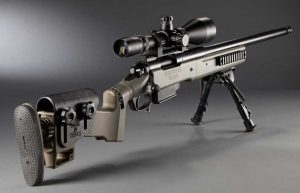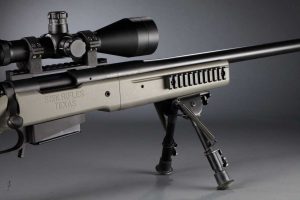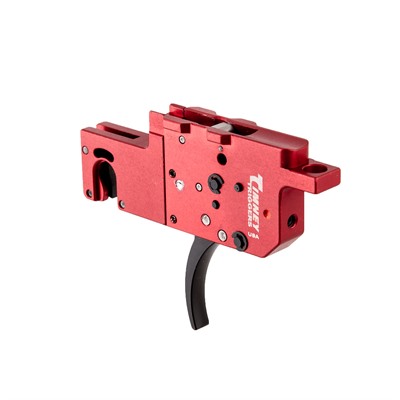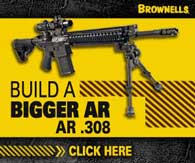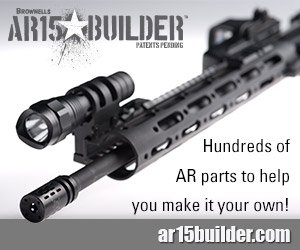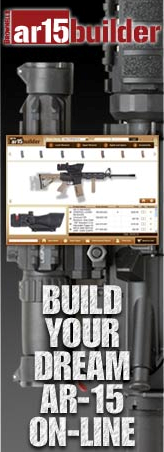MAUSINGFIELD SAFETY AND TESTING
ead this section! You might actually find it interesting and entertaining.
American Rifle Company catastrophically tests firearms built on Mausingfield actions to ensure that the resulting failures will not seriously injure or kill either the user of the firearm or bystanders. It is not safe to use any firearm in any manner other than that prescribed and intended by the manufacturer. The tests described below were performed under controlled conditions by experienced professionals. Do not attempt to replicate these tests yourself.
We conducted tests to observe and document the manner in which gas and particles would escape from a Mausingfield action in the event of a complete case head separation. A Mausingfield action was fitted with a barrel having a special chamber that did not support the portion of the cartridge case that extends 0.22 inches (5.6mm) forward of the extraction groove. To further ensure that the case head would separate from the body, we cut a groove around the case wall of the 300 WSM cartridges used for testing. Detailed video footage of the test was captured using a high-speed camera.
During the first case head separation test, the forward scope rail mounting hole of the receiver was left unobstructed. Upon firing, the case head separated from the case body, releasing gas and particles into the action. A jet of gas and flame escaped from the forward scope mounting hole, and a blast emanated from both the ejection port on the right side of the action and from the bolt-stop port on the left side. After the test, we inspected the action and found that the bolt and receiver assembly were undamaged and fully functional in spite of being contaminated with unburnt powder.
During the second case head separation test, a screw was used to plug the forward scope rail mounting hole of the receiver. During this second test, the camera was repositioned and captured blasts that emanated from the bolt-stop port on the left side of the action, and from between the bolt shroud flange and the aft bridge of the receiver. After the test, we inspected the action and discovered that the bolt and receiver assembly remained functional, but that the forward end of the extractor had been bent during the test.
The fact that the extractor remained undamaged after the first test, but was found to be bent after the second, might suggest that the pressure within the receiver was higher during the second test. This is consistent with the gas being unable to vent through the forward scope rail mounting hole during the second test; however, the deformed case heads recovered after each test were not identical. This means that during the second test, the case head might have impinged upon the extractor in a way that bent it. Because of this uncertainty, it is not possible to draw a definitive conclusion regarding the actual pressures within the forward end of the receiver. Nevertheless, because a jet of gas and flame escaped from the forward scope rail mounting hole of the receiver, it makes sense to vent the receiver, as doing so helps to reduce the mass flow directed towards the shooter. For these reasons, we redesigned the Mausingfield receiver to include vent holes thereafter.
Another test was conducted to observe and document the effects of firing a factory 300 WSM cartridge in a Mausingfield rifle fitted with a properly chambered barrel with the bore obstructed by a metal cleaning rod. Both the receiver and the bolt head of the Mausingfield action used for the test were made from 4340 steel having a measured hardness of approximately 53 Rockwell C. Once again, detailed video footage of the test was captured using the high-speed camera.
When the rifle was fired, blasts emanated from both the ejection port on the right side of the receiver and from the bolt-stop port on the left side. The explosion emanating from the ejection port tore the extractor from its retaining collar and severely deformed it. The extractor was found dangling from the action, captured by its forward end, which remained trapped between the bolt head and the receiver.
The bolt stop and the ejector remained perfectly intact and functional in spite of the explosion of gas through the port in which they are located.
The bullet and cleaning rod were forced approximately eight inches down the bore before coming to a stop. The pressure caused the barrel to swell but not rupture.
Tools were required to open and retract the bolt. Upon doing so, we found fragments of brass within the action. Next, we removed the barrel by unscrewing it from the receiver and found within its chamber the remnant of the 300 WSM case with approximately half of the head missing.
The locking lugs of the bolt head remained largely intact, as did the surface within the receiver that they bear against. The ejector-side slotted lug sustained more damage than did the solid lug. This is not surprising, considering that it is the weaker of the two lugs and bears against the stiffer portion of the receiver. Overall, the lugs performed extremely well, effectively preventing the rearward ejection of the bolt into the shooter’s face.
The fact that the action stayed completely together is extremely important. The bolt was not ejected from the rifle. Although the action was destroyed during the test, it is unlikely that a shooter would have sustained any injury at all, especially if wearing eye protection.
The design of the Mausingfield action, and in particular, its flanged bolt shroud similar to that used in the Mauser 98, prevented much of the escaping gas and particles from reaching the shooter’s face. To simulate a human shooter, we secured a Styrofoam head to the buttstock of the test rifle in a lifelike shooting position. The same head was used for both the case head separation tests and the barrel obstruction test. The head was not cleaned between tests. In the photo below, the byproduct of combustion that accumulated during the three tests is clearly visible on the right cheek of the head. A shooter wearing eye protection and holding the rifle during the tests would not have sustained serious injury. However, the test results emphasize the importance of always wearing eye protection when shooting, because even a single tiny particle striking the eye at high velocity is enough to cause serious injury.
An action needs to have a margin of safety to resist the dangerously high loads resulting from misuse. The margin of safety stems from both proper design and proper heat-treatment of the steel from which the action is made. Therefore, the Mausingfield action must never be subjected to temperatures above 400°F (204°C) for any reason, because doing so will significantly weaken it and compromise its safety margin. The Mausingfield must not be subjected to high-temperature surface treatments such as ferritic nitrocarburizing or salt-bath nitriding, because such treatments are conducted at temperatures ranging from 900-1200° F (480-650° C). These treatments are marketed under several trade names, including Nitrotec®, Tufftride®, Tenifer®, QPQ®, and Melonite®. While these finishes might be suitable for some firearms, they are not suitable for the Mausingfield and may not be suitable for other bolt actions either.
Remember, safety margins are established so that you will not be seriously injured or killed in the event that you do something really stupid or careless. Under no circumstances should you subject any American Rifle Company firearm to an environment that will reduce its safety margins.

